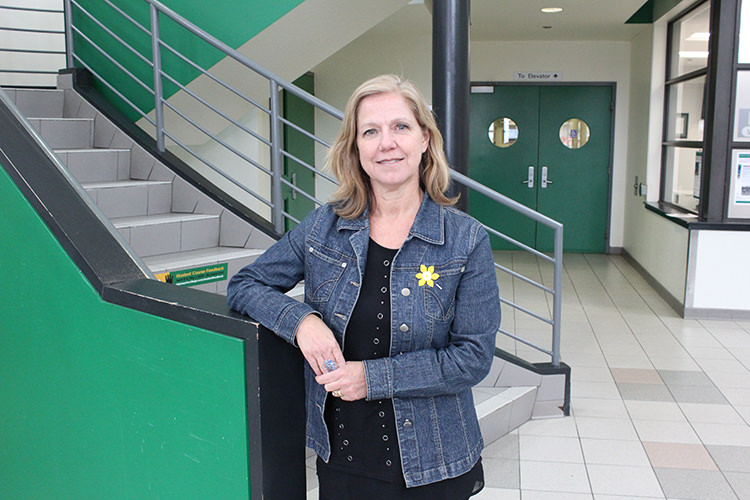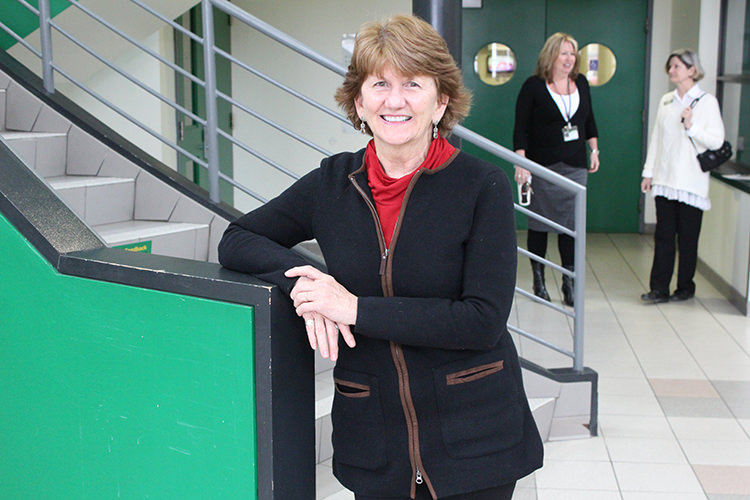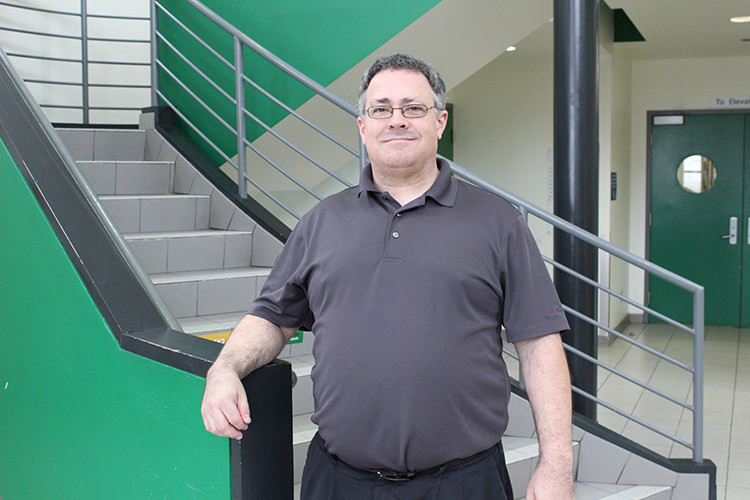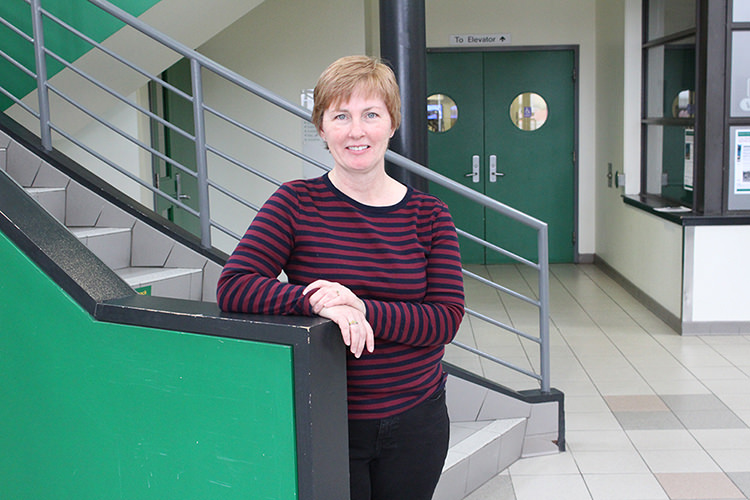Dual Credit Support Teachers Share their Experiences
Posted on Thursday, April 7th, 2016
Sharon Scattolon

Over a 29-year career in education, Sharon Scattolon has worked as a high school English teacher with her guidance qualifications for the Catholic District School Board of Eastern Ontario. She took a four-year break from the high school environment in order to serve as a consultant in student success at her school board. Sharon now works with dual credit students at the five westernmost high schools in her board.
What do you like about being a dual credit teacher?
“What I really like about it is helping with the transition to postsecondary. Whether the student is looking at university, college or apprenticeship, giving them the taste of what postsecondary looks like and showing them that they can do it. There are things that they need to know about the environment that are different from high school. The best way to find that out is to try out a dual credit.”
What is the biggest challenge you face as a dual credit teacher?
“The unique challenge for our school board is that most of our schools are rural, except for the ones in Cornwall – they have nice access to St. Lawrence College in Cornwall. But for our other schools, our students are picking up a course in Kingston, Brockville, Ottawa or Perth, depending on their interests and where they’re located. The logistics of transportation is the unique challenge, as well as convincing students to take time out of their high school schedule to go to Ottawa for a three-hour class.”
What is the most inspiring story about a student you’ve witnessed as a dual credit teacher?
“This is just one of many. I had a high school student named Ryan, who really didn’t like high school. All we have at our high school in Perth is construction, and he was interested in automotive. He started doing some co-op in the summer between Grade 10 and Grade 11. He did co-op all the way through, signed on as an apprentice in Grade 11, and came to Algonquin to do a level-one course in his Grade 12 year. He struggled a lot with the math in the theory, but they were really great here about supporting him. If he wasn’t successful in that math course, he might’ve just said, ‘I guess I can’t be a mechanic. I can’t do it.’ Whereas with the dual credit, because the supports were in place, he got through the math and he got through the Level 1.
Ryan walked the stage at graduation a third of his way through the apprenticeship already. I don’t think he had even turned 18 yet. His mother was bawling; she was so happy we found a way to get him out of sitting at that school desk and doing what he loved. He’s now as successful as the kids we’re reading about that went off to university and to college, or are taking over the family business. His level of success is way up there among his class.”
Margie Chaput

Over a long career in education, Margie Chaput started out as a high school gym teacher at St. Pius High School before going on to develop the co-op program for the Ottawa Catholic School Board (previously the Carleton Catholic School Board). She later became the consultant for physical and health education for the OCSB. After the launch of the dual credit program at Algonquin College in 2006, Margie became the first support teacher to work with dual credit students at the college.
What do you like about being a dual credit teacher?
“I really like that I get to do a lot of one-on-one work with the students. I get to mentor them when they need it. I like that they’re facing a unique challenge and I get to support them through that. I like being at the college in a different environment. I like all the teachers that I work with in the schools out there that are sending their students. I like a lot of the students I’m meeting, the people I’m meeting, the professors I’m meeting. I like the excitement I see in the students.”
What is the biggest challenge you face as a dual credit teacher?
“One of the unique challenges is that the students are transient. They’re coming from all of these different schools, where they have a teacher at their school who is their home teacher. You become their alternate teacher. I find it very similar to co-op with respect to monitoring a student. The only difference is they are only on loan to me; they aren’t my students from the get go, and then they leave me and I don’t get to see them continue to flourish. One of the challenges becomes, then, communication with them. It’s not as easy as it at school where you say, ‘I’ll see you tomorrow.’ Communication can be a little more challenging.”
What is the most inspiring story about a student you’ve witnessed as a dual credit teacher?
“It’s not just one student, but I’ve seen many students who have come from, in some cases, war-torn countries, or a really, really difficult living situation. I have been blessed to be a part of their life and to help them through some of their difficult integration into the college, as well as to get to know them and discover what wonderful people they are. They’re bright, but they’ve had just so many imposed struggles on them.
One of them was a student who came from another country and had been badly treated. She had medical issues that were still affecting her ability to try to study. The trust she put in me, and how I was able to help her through that, and how she came here and went to the college and finished her diploma — it was very heartwarming and rewarding to see the spirit and to be able to help that spirit soar.”
David Mowat

David Mowat has been spent the majority of his 20-year career working for the Upper Canada School Board’s Adult and Alternative school. He worked in guidance for many years before transitioning into the dual credit role seven years ago.
What do you like about being a dual credit teacher?
“I really enjoy helping students to find their way through the high school diploma, but also through the transition piece to postsecondary. It’s so nice to be involved with a program that has such a positive impact on so many students. The students are often at risk, so seeing students who perhaps never thought they could go to college go to college and be successful is the best part of the job.”
What is the biggest challenge you face as a dual credit teacher?
“For our board, it’s basically Eastern Ontario except Ottawa Carleton. We go east to Lancaster and Vankleek Hill, and as far West as Ganonoque, and then Perth, Almonte and of course the 401 corridor. I’ve got students at the three campuses of St. Lawrence College, and in Perth and Ottawa at Algonquin. The challenge is maintaining communication with all of those students. I text, email and call, but nothing will ever replace the value of face to face. That’s a challenge, but I enjoy it.”
What is the most inspiring story about a student you’ve witnessed as a dual credit teacher?
“There are a lot, but a student I worked with came in when she was in her late teens, and she was with us for a number of years. I was recruiting students for dual credit and asking staff for recommendations. They put her name forward. I talked to her, and I still remember the conversation because she was so taken aback that the staff thought she could be successful in college. She subsequently did three dual credits, did extremely well in all of them, and then went on to St. Lawrence in Cornwall for Early Childhood Education. She is now employed at an elementary school in Cornwall.”
Lorie Keon-Leahey

Lorie Keon-Leahey has been working in co-op for last seven years for the Renfrew County Catholic District School Board, and has been working as a dual credit support teacher for the past year.
What do you like about being a dual credit teacher?
“I like the opportunity and exposure to the college it provides. I think that’s great.”
What is the biggest challenge you face as a dual credit teacher?
“It’s getting the students to understand that our criteria in school is different than in college. The college is stricter on things like deadlines and attendance. We’re only about a year into the dual credit program here, but that’s been the biggest challenge.”
- Posted in